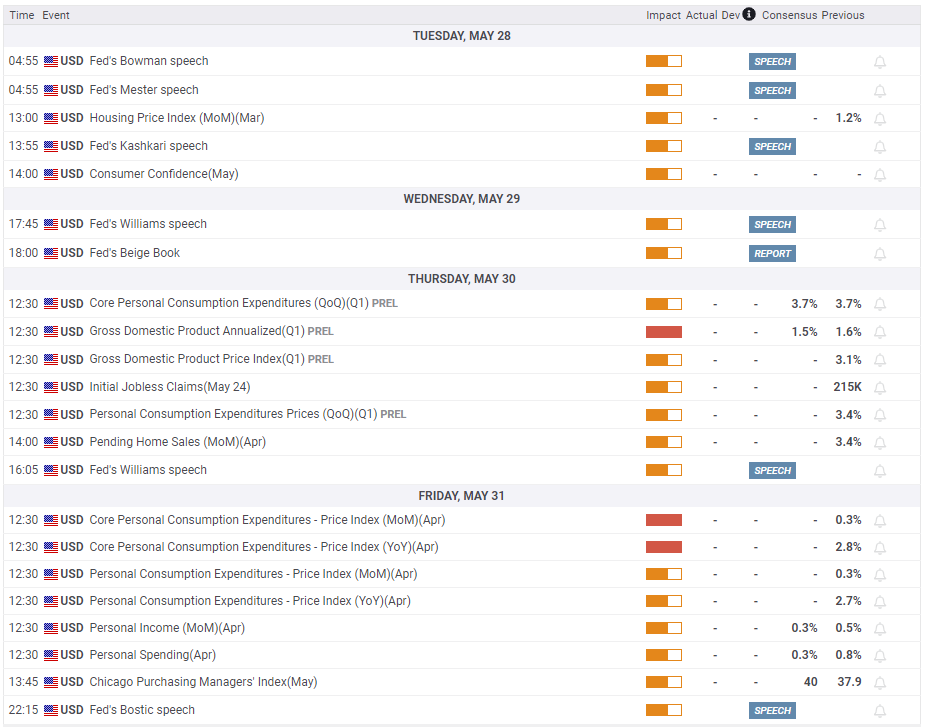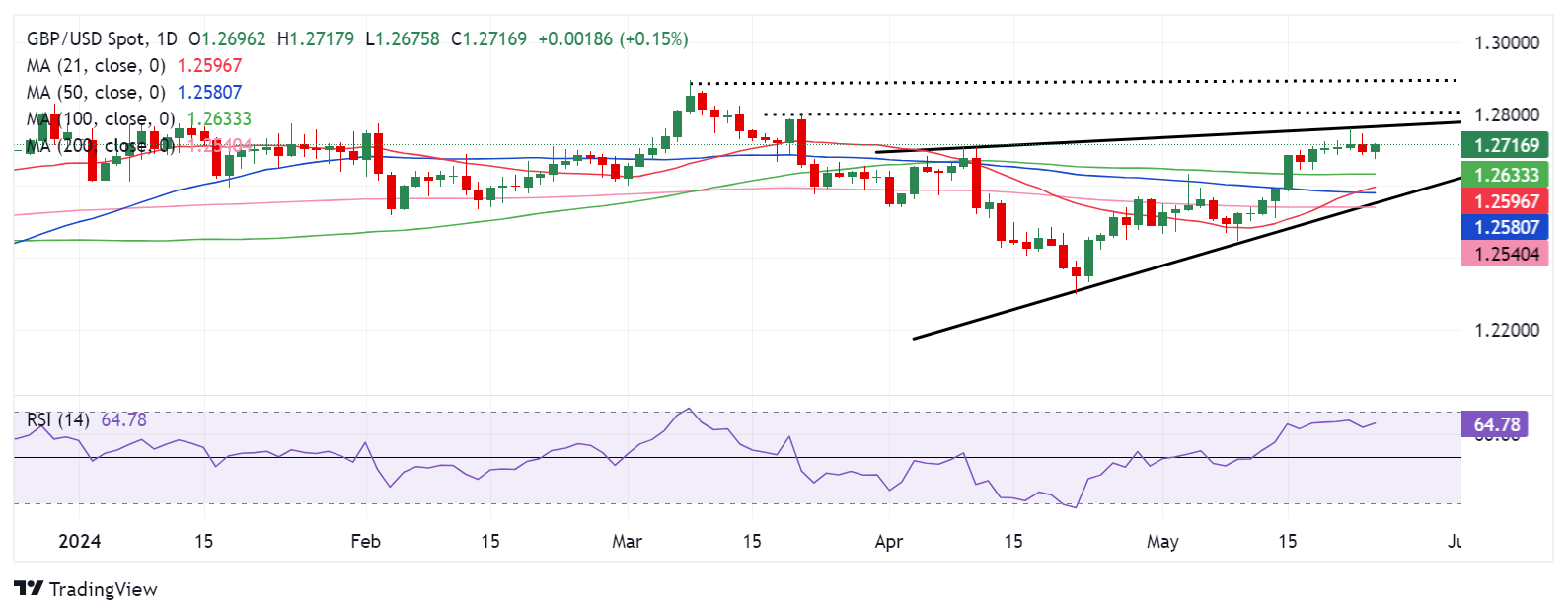- The Pound Sterling hit two-month highs above 1.2750 against the US Dollar.
- The GBP/USD uptrend is likely to stay intact in the holiday-shortened week ahead.
- The Pound Sterling eyes 1.2900 amid double bullish crossovers and RSI.
The Pound Sterling (GBP) managed to eke out minor gains against the US Dollar (USD) this week after the GBP/USD pair touched the highest level in two months above 1.2750.
Pound Sterling gives in to the US Dollar resurgence
Having started the week on the front foot, the Pound Sterling struggled to resist the US Dollar resurgence, but GBP/USD eventually posted mild gains, extending the previous week’s rebound.
The hawkish sentiment surrounding the fading expectations of interest rate cuts by both the Bank of England (BoE) and the US Federal Reserve(Fed) emerged as the underlying theme this week, with resurgent US Dollar demand partly offsetting the optimism seen around the British Pound.
Monday’s holiday-thinned conditions kept the pair in a familiar range around 1.2700 but it was the hotter UK Consumer Price Index (CPI) report on Tuesday that endorsed a fresh advance in the Pound Sterling, prompting GBP/USD to extend its strength into the first half of Wednesday’s trading.
The Office for National Statistics (ONS) said Tuesday that inflation, as measured by the CPI, fell to 2.3% in the year to April, down from 3.2% in March. The reading, however, surpassed the market expectations of a deeper slowdown to 2.1%. Services inflation declined to 5.9% YoY in April, as against March’s reading of 6.0% and the estimated 5.4% figure.
The slower-than-expected decline in inflation dashed hopes of a June BoE rate cut, lifting the GBP/USD pair to fresh two-month highs of 1.2762 in the aftermath.
However, the hawkish Minutes of the Fed’s May policy meeting combined with the recent cautious remarks from several Fed policymakers pushed back against aggressive Fed rate cut expectations and revived the demand for the US Dollar across the board, triggering a retracement in the pair.
The Fed Minutes released on Wednesday showed that “various participants mentioned a willingness to tighten policy further should risks to inflation materialize in a way that such an action became appropriate.” The Minutes also suggested that the Fed officials grew more concerned about the stubbornness of inflation.
A recent slew of speeches from several Fed policymakers have also warranted caution on the persistence of inflation, leaning in favor of delayed rate cuts.
Meanwhile, data on Thursday showed that the preliminary US Composite PMI, which tracks the manufacturing and services sectors, jumped to 54.4 this month, registering the highest level since April 2022 and following a final reading of 51.3 in April.
Robust US data affirmed the economic resilience and further tempered bets of a dovish Fed policy pivot later this year, providing a fresh boost to the Greenback at the expense of the Pound Sterling.
GBP markets also turned cautious following the confirmation of the UK general election on July 4.
Hawkish Fed expectations continued to dent risk sentiment, further acting as a headwind to the risk currency British Pound on Friday. Meanwhile, downbeat UK Retail Sales data for April offered extra legs to the GBP/USD correction.
The UK Retail Sales dropped 2.3% over the month in April vs. -0.4% expected and -0.2% in March, the latest data published by the Office for National Statistics (ONS) showed Friday. Despite the initial decline following the data, the Pound Sterling managed to gain some ground and remained above 1.2700, as the improving risk mood didn’t allow the USD to preserve its strength heading into the weekend.
What to watch for in the US inflation week.
It's yet another holiday-shortened week, as the US and the UK traders will be away on Monday, enjoying their Memorial Day and Spring Bank Day long weekend, respectively.
Tuesday and Wednesday are quiet in terms of data releases from both sides of the Atlantic but Fed speakers are likely to dominate, with the US Dollar price action expected to drive the GBP/USD pair.
The second estimate of the first-quarter US Gross Domestic Product (GDP) will be reported on Thursday. At the same time, the weekly Jobless Claims will be released, followed by the Pending Home Sales.
The high-impact US Core PCE Price Index, the Fed’s preferred inflation gauge, will stand out on Friday amidst other low-tier US macro data.
GBP/USD: Technical Outlook
As observed on the daily chart, GBP/USD has been traversing in a seven-week-long rising wedge formation.
In order to invalidate the bearish wedge, the pair needs to yield a daily closing above the upper boundary of the pattern, aligned at 1.2765.
Acceptance above the latter would negate any near-term bearish bias, opening the door for a retest of the March 21 high of 1.2804.
The next topside barrier is seen at the March 8 high of 1.2894, above which a test of the 1.2950 psychological level will be inevitable.
The double bullish crossovers charted this week justify the upside potential. The 21-day Simple Moving Average (SMA) and the 200-day SMA crossover occurred on Monday, while the 21-day SMA and 50-day SMA Bull Cross was confirmed on Thursday.
Additionally, the 14-day Relative Strength Index (RSI) holds well above the 50 level, currently at 61.50, suggesting that the upside remains intact for the Pound Sterling.
However, if buyers face rejection at the upside hurdle of the potential rising wedge, the immediate downside could be capped by the 100-day SMA at 1.2633.
Further south, the confluence zone of the 20-day SMA and the 50-day SMA at around 1.2580 will also test the bullish commitments.
The last line of defense for buyers is seen at the critical support near 1.2535, where the lower boundary of the wedge pattern and 200-day SMA intersect.
A sustained break below the latter will initiate a fresh downtrend toward the 1.2400 threshold.
Pound Sterling FAQs
The Pound Sterling (GBP) is the oldest currency in the world (886 AD) and the official currency of the United Kingdom. It is the fourth most traded unit for foreign exchange (FX) in the world, accounting for 12% of all transactions, averaging $630 billion a day, according to 2022 data. Its key trading pairs are GBP/USD, aka ‘Cable’, which accounts for 11% of FX, GBP/JPY, or the ‘Dragon’ as it is known by traders (3%), and EUR/GBP (2%). The Pound Sterling is issued by the Bank of England (BoE).
The single most important factor influencing the value of the Pound Sterling is monetary policy decided by the Bank of England. The BoE bases its decisions on whether it has achieved its primary goal of “price stability” – a steady inflation rate of around 2%. Its primary tool for achieving this is the adjustment of interest rates. When inflation is too high, the BoE will try to rein it in by raising interest rates, making it more expensive for people and businesses to access credit. This is generally positive for GBP, as higher interest rates make the UK a more attractive place for global investors to park their money. When inflation falls too low it is a sign economic growth is slowing. In this scenario, the BoE will consider lowering interest rates to cheapen credit so businesses will borrow more to invest in growth-generating projects.
Data releases gauge the health of the economy and can impact the value of the Pound Sterling. Indicators such as GDP, Manufacturing and Services PMIs, and employment can all influence the direction of the GBP. A strong economy is good for Sterling. Not only does it attract more foreign investment but it may encourage the BoE to put up interest rates, which will directly strengthen GBP. Otherwise, if economic data is weak, the Pound Sterling is likely to fall.
Another significant data release for the Pound Sterling is the Trade Balance. This indicator measures the difference between what a country earns from its exports and what it spends on imports over a given period. If a country produces highly sought-after exports, its currency will benefit purely from the extra demand created from foreign buyers seeking to purchase these goods. Therefore, a positive net Trade Balance strengthens a currency and vice versa for a negative balance.
Information on these pages contains forward-looking statements that involve risks and uncertainties. Markets and instruments profiled on this page are for informational purposes only and should not in any way come across as a recommendation to buy or sell in these assets. You should do your own thorough research before making any investment decisions. FXStreet does not in any way guarantee that this information is free from mistakes, errors, or material misstatements. It also does not guarantee that this information is of a timely nature. Investing in Open Markets involves a great deal of risk, including the loss of all or a portion of your investment, as well as emotional distress. All risks, losses and costs associated with investing, including total loss of principal, are your responsibility. The views and opinions expressed in this article are those of the authors and do not necessarily reflect the official policy or position of FXStreet nor its advertisers. The author will not be held responsible for information that is found at the end of links posted on this page.
If not otherwise explicitly mentioned in the body of the article, at the time of writing, the author has no position in any stock mentioned in this article and no business relationship with any company mentioned. The author has not received compensation for writing this article, other than from FXStreet.
FXStreet and the author do not provide personalized recommendations. The author makes no representations as to the accuracy, completeness, or suitability of this information. FXStreet and the author will not be liable for any errors, omissions or any losses, injuries or damages arising from this information and its display or use. Errors and omissions excepted.
The author and FXStreet are not registered investment advisors and nothing in this article is intended to be investment advice.
Recommended Content
Editors’ Picks

AUD/USD stays firm around 0.6400 after Australian CPI/ China PMIs
AUD/USD is holding firm at around 0.6400 in the Asian session on Wednesday. Hotter-than-expected Australian quaterly inflation data doused expectations of RBA rate cuts, underpinning the Aussie. However, mixed Chinese NBS and Caixin PMI data cap the pair's upside amid a modest US Dollar uptick.

USD/JPY consolidates below 142.50 as traders keenly await BoJ policy decision
USD/JPY oscillates in a narrow band below 142.50 early Wednesday as traders move to the sidelines ahead of the crucial BoJ policy meeting. The divergent BoJ-Fed expectations and trade-related uncertainties support the Japanese Yen and cap the pair despite a renewed US Dollar upside.

Gold: Will US advance Q1 GDP data revive its uptrend?
Gold price holds lower ground in Asian trading on Wednesday, but remains within a familiar range. Gold traders eagerly await the release of the US first-quarter Gross Domestic Product (GDP) data for a fresh directional impetus.

Trump Media announces new token launch and native crypto wallet in latest Shareholder letter
Trump Media unveils plans to launch a utility token and crypto wallet to monetize Truth Social and expand its streaming services. Markets react with a 10% drawdown on the Solana-hosted official TRUMP memecoin.

May flashlight for the FOMC blackout period – Waiting for the fog to lift
We expect the FOMC will leave its target range for the federal funds rate unchanged at 4.25-4.50% at its upcoming meeting on May 6-7, a view widely shared by financial markets and economists. Market pricing currently implies only a 9% probability of the FOMC cutting the fed funds rate by 25 bps.

The Best brokers to trade EUR/USD
SPONSORED Discover the top brokers for trading EUR/USD in 2025. Our list features brokers with competitive spreads, fast execution, and powerful platforms. Whether you're a beginner or an expert, find the right partner to navigate the dynamic Forex market.

